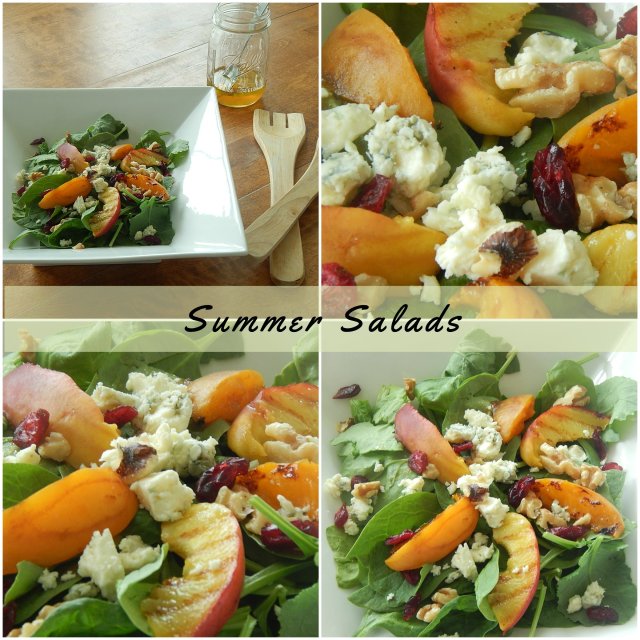 I get so excited about salad…seriously. And summer is the best season to play around with different combinations of flavors and textures because there’s such a wide variety of in-season fruits and veggies to try. Salads, though historically considered the forgotten side dish (or first course) – something you have to endure in order to get to the “star” of the meal – the main course- do not only serve as a mere opportunity to consume some veggies, but can actually serve as the star of the meal. Yes, I do mean the main course! For lunch or dinner (or why not for a snack?), salads offer a pallet of different colors, flavors, and textures. It’s artistic, really. The beauty of salad is, you can’t really go wrong. No matter what base you use or ingredients you add in, you never wind up with a bad combination.
I get so excited about salad…seriously. And summer is the best season to play around with different combinations of flavors and textures because there’s such a wide variety of in-season fruits and veggies to try. Salads, though historically considered the forgotten side dish (or first course) – something you have to endure in order to get to the “star” of the meal – the main course- do not only serve as a mere opportunity to consume some veggies, but can actually serve as the star of the meal. Yes, I do mean the main course! For lunch or dinner (or why not for a snack?), salads offer a pallet of different colors, flavors, and textures. It’s artistic, really. The beauty of salad is, you can’t really go wrong. No matter what base you use or ingredients you add in, you never wind up with a bad combination.
The basics:
- Greens – Dark, leafy greens such as spinach, kale, Romaine lettuce, and arugula serve as not only a beautiful, rich base upon which to pile up colorful toppings, they are super healthy and tasty. Water-based lettuces such as iceberg lettuce are also a good base because they are incredibly refreshing especially on the hottest of summer days.
- Tomatoes – Deep red tomatoes (grape, cherry, or sliced wedges of larger tomato varieties) are always a hit. Try heirloom varieties that add different color impressions – purple, yellow or orange tomato varieties.
- Other Veggie Add-Ins – shredded carrots, thinly sliced radishes, purple onion slivers, colorful bell pepper strips (red, orange, yellow, purple), and, of course, cucumbers
- Protein – If serving salad as a main course, protein is an important consideration. Add meats such as chopped turkey breast or ham, grilled or roasted chicken, tuna fish (canned or fresh), other seafood such as cooked salmon, or shellfish such as shrimp and crab meat are awesome add-ins. Even hard-boiled eggs. The possibilities are endless. If going meatless, add beans, any variety or a mix of a few different varieties – garbanzos, kidneys, black-eyed peas, etc. Again, endless possibilities
- Fruit – berries of any kind – blueberries, raspberries, strawberries, apple/pear slices. Try grilling fruit such as peaches, plums, apricots, watermelon, pineapple. So Good! Add dried cranberries. Try citrus fruit such as orange or grapefruit segments.
- Crunch – I like some crunch in my salads. In my opinion, they make salads more satisfying. Opt for the traditional crouton (you can make these yourself), or try nuts (almonds, peanuts, chopped walnuts, pecans, hazelnuts).
- Cheese – I don’t know about you, but I love cheese in my salad. It just adds another level of flavor and texture that’s so satisfying. Sharp, flavorful cheeses take salad to the next level. Try feta, goat cheese, bleu cheese, fontina, parmesan, or ricotta salata (similar to feta). Sharp cheddar is an excellent addition, too. Cubed, shredded, or crumbled, you can’t go wrong with a little cheese atop your salad 🙂
- Dressing – You can’t go wrong with a drizzle of extra virgin olive oil and any kind of vinegar – balsamic, wine vinegars, apple cider vinegar, squirt of lemon juice, etc. YOU DO NOT NEED TO BUY BOTTLED SALAD DRESSINGS! It’s taken me awhile to realize this. I always stocked my fridge with bottles upon bottles of salad dressing. Not anymore! Dressing is so easy and inexpensive to make yourself with ingredients you have on hand.
The salad featured in the photo is a Grilled Stone Fruit and Bleu Cheese Salad with a Honey Vinaigrette Dressing. So easy and good! Here’s how I did it:
Spinach/Kale mixed greens
Grilled Peach and Apricot Slices – Spray a grill pan with non-stick cooking spray, and preheat over medium heat. Slice stone fruit around pit and remove (similar to how you would slice an avocado). Slice in wedges and place on grill. Grill for about 4 minutes per side.
Crumbled Bleu Cheese
Chopped walnuts
Handful of dried cranberries
For the dressing:
Most dressing recipes you read will call for a 2 to 1 ratio of oil to vinegar. I say “bunk”! I use equal amounts of oil and vinegar; otherwise, all you taste is the oil. Also, use good quality extra virgin olive oil. A little dressing goes a long way here.
1 tbs honey
3 tbs apple cider vinegar
3 tbs extra virgin olive oil
dash of salt & pepper to taste
Whisk all ingredients together and pour over salad right before serving. Couldn’t be easier!




![Linguini with Kale Pesto and Shrimp DSCN0191[1]](https://theseasonedheart.files.wordpress.com/2015/02/dscn01911.jpg?w=640&h=480)
![DSCN0180[1]](https://theseasonedheart.files.wordpress.com/2015/02/dscn01801.jpg?w=640&h=480)
![DSCN0182[1]](https://theseasonedheart.files.wordpress.com/2015/02/dscn01821.jpg?w=640&h=480)

![DSCN0188[1]](https://theseasonedheart.files.wordpress.com/2015/02/dscn01881.jpg?w=640&h=480)